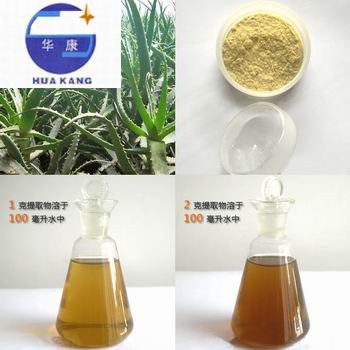

Cape aloe powder
Telephone Bargaining
Cape Aloe Powder Profile
Also known as
Aloe ferox, and Cape Aloe
PLEASE NOTE! A different species of aloe called Aloe barbadensis(Curacao aloe) is the common species which is predominantly used to produce Aloe gel and juice, though it is also made into powder. Cape aloe or Aloe ferox, is produced by drying the inner fillet of the leaf of the plant and milling it into a powder. The end result is a powder which is green-brown in color.
Introduction
The cactus-like aloe is a favorite houseplant and home remedy for burns, scrapes, cuts, and scratches. It has been used for millennia to treat skin problems. Alexander the Great is said to have sent his army from Greece to an island off the coast of Somalia just to obtain its crop of aloe.
Constituents
Aloe-emodin, arginine, magnesium, salicylates, serine, vitamin C, and complex polysaccharides including acemannan.
Parts Used
The inner fillet of the leaf, dehydrated and powdered.
Typical Preparations
The clear, slightly slimy gel collected from the fleshy part of the leaf is taken internally for its antioxidant, anticancer, antiviral, and immunostimulant effects, or applied directly to the skin to soothe inflammation and accelerate healing. Aloe gel is used fresh or stabilized. "Bitter Aloe" is a dried latex taken from the "peel" of the leaves, more precisely the double wall of the leafs water sacs. When bitter aloe is first extracted from the leaf, it is yellow, but it turns brown as it dries. Acemannan is a complex carbohydrate chemically extracted from the gel. It is used in experimental pharmaceutical preparations as a treatment for viral infections and cancer. Acemannan is not a whole herb product. The type of Cape Aloe sold by Mountain Rose Herbs is made from the inner fillet of the leaf dehydrated and powdered.
Summary
Aloe is used to treat eczema (atopic dermatitis), frostbite, psoriasis, and wounds from cosmetic dermabrasion and dental procedures involving the gums. Generally, best results are obtained when the wound only involves the upper layers of the skin. Aloe is not recommended for deeper wounds because it causes the skin to tighten too soon, hindering the recovery of the deeper layers. The herb contains at least seven antioxidant compounds that prevent the production of leukotrienes, chemical agents of inflammation released by mast (white blood) cells. Aloe gel releases natural salicylates, compounds related to aspirin, and relieves pain as it encourages healing. Aloe gel is also useful for treating genital herpes. One study found that using an aloe cream reduced the average time for healing from 12 days to 5, and that herpes lesions were 10 times more likely to be completely healed within 10 days with aloe treatment, compared to a placebo. Aloe is also useful for treating seborrhea, a condition of red, scaly, oil eruptions on the eyelids, eyebrows, nose, ear, upper lip, chin, chest, and groin. Aloe creams usually relieve symptoms of seborrhea in 4 to 8 weeks. Aloe "juice" lowers blood sugars of diabetics and helps relieve ulcerative colitis.
Precautions
Internally Cape aloe and its cousins are not recommended while nursing or pregnant. It is a bulk forming laxative and adequate fluids must be taken. Use of this herb may cause gastrointestinal upset, and watery stools. Not recommended for long term use.
health food,pet's food
| Industry Category | |
|---|---|
| Product Category | |
| Brand: | |
| Spec: | |
| Stock: | |
| Origin: |
